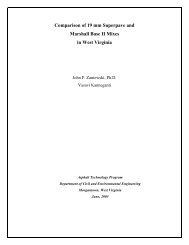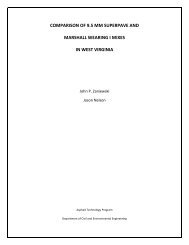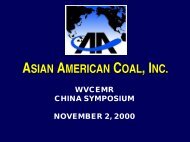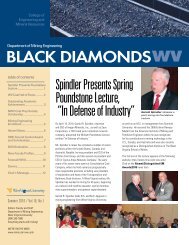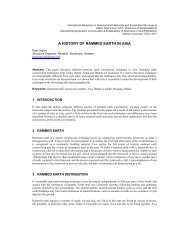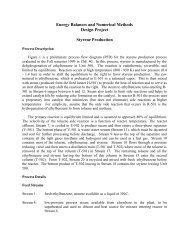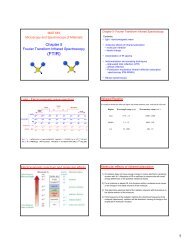Polymer Composite Retrofits Strength Concrete Structures - CEMR
Polymer Composite Retrofits Strength Concrete Structures - CEMR
Polymer Composite Retrofits Strength Concrete Structures - CEMR
Create successful ePaper yourself
Turn your PDF publications into a flip-book with our unique Google optimized e-Paper software.
Issue focus:<br />
How DOD Research Protects<br />
People and Buildings<br />
The AMPTIAC Quarterly, Volume 6, Number 4<br />
US Government Initiatives Reduce Terrorist Threat to Personnel and <strong>Structures</strong> … 5<br />
Wade Babcock and David Rose, AMPTIAC, Rome, NY<br />
The US Government has been addressing the issue of protecting people and stru c t u res from terrorist attacks for many years. T h i s<br />
a rticle provides an introduction to the federal coordinating group which directs these activities, and the DOD agency that focuses<br />
on military issues. This article also features insight from some of the key people within DOD who direct and take part in these effort s .<br />
The TSWG – Closeup … 8<br />
Protecting Personnel at Risk:<br />
DOD Writes Anti-Terrorism Standards to Protect People in Buildings … 11<br />
Colonel Joel C. Bradshaw III, PE, Chief of Military Construction Programs, Office of Deputy Under Secretary of Defense<br />
(Installations and Environment), The Pentagon, Washington, DC<br />
The DOD takes the issue of protecting its personnel very seriously and has recently completed the codified anti-terrorism standards<br />
which began a few years ago as guidance and interim directives. Colonel Bradshaw is in a unique position to explain some<br />
of the critical steps and policy issues that drove this process, as well as the top-level directives and initiatives that are contained in<br />
the document.<br />
DOD Protective Design Manuals Have Wide Application … 17<br />
Patrick Lindsey, PE, Protective Design Center, US Army Corps of Engineers, Omaha, NE<br />
Factors such as site selection, building location on the site, use of fences and clear space, as well as vegetation and structural reinforcements<br />
are all critical to protecting a building and its occupants from various threats. Incorporating protection into a facility’s<br />
design is the best way to achieve a desired level of protection at a reasonable cost. Patrick Lindsey of the Protective Design Center<br />
summarizes many of the key features and considerations to be accounted for, and introduces the DOD resources available.<br />
Homeland Security vs. Homeland Defense… Is there a difference … 24<br />
<strong>Polymer</strong> <strong>Composite</strong> <strong>Retrofits</strong> <strong>Strength</strong>en <strong>Concrete</strong> <strong>Structures</strong> … 25<br />
Robert Odello, Director, Waterfront <strong>Structures</strong> Division, Naval Facilities Engineering Services Center, Port Hueneme, CA<br />
The Navy is using composite materials to strengthen pier decks and support columns. Some of these structures were not designed<br />
for current load requirements and therefore need to be upgraded while others are deteriorating and the retrofits can bring them<br />
back to full service. The systems outlined in this article are also being considered for use in buildings to increase both dynamic<br />
shock-induced load capability and the ability to withstand negative loading. Robert Odello describes a program that is proving that<br />
composite systems offer viable, serviceable, and cost effective ways of strengthening real-world concrete structures. These programs<br />
are also educating both the government and industry on how to specify, install and maintain them. Lessons learned in these Navy<br />
projects will help further advance the protection and hardening of land-based structures.<br />
Blast Retrofit Research and Development:<br />
Protection for Walls and Windows … 31<br />
David Coltharp and Dr. Robert L. Hall, Geotechnical and <strong>Structures</strong> Laboratory, US Army Corps of Engineers,<br />
Engineer Research and Development Center, Vicksburg, MS<br />
Conventional building components are highly vulnerable to terrorist vehicle bomb attack. Common annealed glass windows break<br />
at very low blast pressures and the resulting flying glass fragments are a major cause of injuries in many bombing incidents. Masonry<br />
in-fill walls are also weak elements and another source of hazardous debris. Through the combined research and development efforts<br />
of multiple DOD agencies and the State Department, significant advances have been made since 1996 in improving methods<br />
for protection of conventional military and government facilities. David Coltharp presents some of the unique and innovative<br />
methods that have been developed for retrofitting windows and walls, and describes how they increase the blast capacity of these<br />
vulnerable components, decrease standoff requirements, and improve protection for personnel.<br />
Mark Your Calendar … 38<br />
A M P T I AC is a DOD Information Analysis Center Administe red by the Defense Information Systems Age n c y,<br />
D e fense Te chnical Information Center and Opera ted by Alion Science and Te ch n o l o g y



